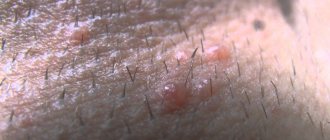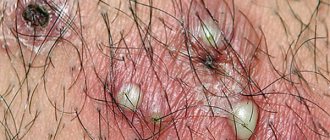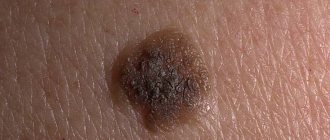The human papillomavirus can cause a lot of trouble, one of which is warts. They can ruin the appearance of the skin and cause inconvenience during hygiene procedures and wearing clothes. But the main problem of this disease is the risk of degeneration of benign cells into malignant ones. Therefore, removal of tumors is considered a necessary measure. But what to do if a wart is discovered during pregnancy? After all, this “interesting” situation does not allow the use of standard methods of treating this disease, but at the same time, I don’t want to leave it “as is.”
What is a wart?
Warts are called benign neoplasms. They are caused by HPV - human papillomavirus. Almost every person has warts. Neoplasms can be easily transmitted through objects or direct contact. Sometimes a wart does not make itself felt for a long period.
A woman may have a tumor (and not know about it) even before pregnancy. And during this period, hormonal changes in the body begin, and immunity decreases. All this stimulates the manifestation of hidden warts during pregnancy.
Types of warts
Neoplasms most often appear on the extremities, face and mucous membranes. Warts are divided into several types:
- Ordinary papillomas look like rounded nodules ranging in size from one to ten millimeters. Warts protrude slightly above the skin. The color of papillomas can be brown, pink or flesh-colored. Papillomas are dense, with a rough surface. Warts mainly appear on the face.
- Flat papillomas do not grow more than three millimeters. Such neoplasms protrude slightly above the skin. Most often, warts appear on the face and back of the hands. The growths may be brown, yellow, or skin-colored. Flat warts appear in a whole group.
- Plantar warts during pregnancy are more troublesome than others. Such papillomas are initially very painful, and when a woman is expecting a child, the discomfort increases. Soreness occurs due to constant friction. Plantar warts are yellowish, dense, similar to a dry callus. If papillomas cause severe discomfort, they are removed.
- Genital warts appear on the genitals, in the folds. At first they appear as small pink bubbles, then they become pointed and grow to a whole bunch.
- Thread-like papillomas have an elongated shape, attached to the skin on a small stalk. They can grow up to three centimeters in length. Most often they appear on the eyelids, armpits, genitals and neck. This type of wart occurs more often than other types during pregnancy.
On the chest
Growths on a woman's chest
What is this growth on the nipples during pregnancy? This is a benign formation of pink or brown color. It may not bother the woman or may interfere with her by coming into contact with clothing. Why did warts appear on the chest during pregnancy? Infection occurred through a towel, hygiene items, or through contact with another person. The woman might not even know about it. But due to an interesting situation, due to hormones, the virus became more active. What else could cause the wart to form? Uncomfortable underwear, breast injuries, poor hygiene, etc. If warts appear on the nipples during pregnancy, they do not need to be removed if they do not interfere, are not injured, or rubbed.
When a woman gives birth, her body will recover, they will disappear on their own. If pain or inflammation occurs, they are removed. The growths should be shown to your doctor so that he can decide whether to leave them or remove them.
Intraductal papilloma
There is another type of growth, intraductal papilloma or papillary cystadenoma. It develops in girls and women of different ages. The cause of its appearance is hormonal imbalance. Changes in hormone levels are caused by many reasons, one of them is pregnancy.
Signs of the disease:
- Unpleasant sensations appear in the chest, a burning sensation.
- The nipples become very sensitive.
- Discharge appears from the nipple. They can be abundant or insignificant, sometimes mixed with blood. The color of the discharge is different: transparent, white, and with a green or yellow tint.
- Inflammation, weakness, temperature (if there was injury to the neoplasm).
- A large growth can be felt with your hands.
If there was a pregnancy, warts on the nipples may disappear on their own. But if a growth appears inside the breast, then it needs to be treated; such papillomas rarely resolve. Be sure to visit a doctor who will first make a correct diagnosis and conduct an examination to make sure that it is intraductal papilloma. Then he will prescribe treatment. Surgery may be needed. Or the doctor will prescribe antiviral, immunostimulating drugs, and select treatment that is suitable for pregnant women.
Intraductal papilloma requires immediate treatment
Causes of warts
The main reason why warts appear during pregnancy is a virus in the body. The infection appears due to a weakened immune system and hormonal changes that occur during the period when a woman is expecting a child. At this time, skin formations grow greatly.
Warts occur due to the appearance of the papilloma virus in the body. It has several varieties. Most often, warts are simple and appear on the body. It is worse if neoplasms appear on the genitals. This can create problems during pregnancy.
Diagnostics
In order to detect the presence of HPV in the body , it is enough to take a test to determine it. As a rule, the expectant mother undergoes a similar procedure during the observation period.
A referral for analysis is issued by a doctor who is seeing a pregnant woman at the antenatal clinic.
If one or more bumps of unknown origin are found on any area of the skin, you should immediately see a doctor .
Determining the nature of a neoplasm on your own is quite dangerous, since the result may not always be correct.
Warts - “Live Healthy!” program
Why are warts dangerous during pregnancy?
A wart itself during pregnancy does not pose a danger to the mother and the unborn baby. But self-medication using folk methods can do a lot of harm. If the warts do not cause pain and do not grow, it is better not to touch them until the baby is born. Only genital warts that appear on the genitals require treatment.
Some tumors can grow so large that they create an obstacle to the birth of a child. When he leaves the mother's womb, the warts that appear on the birth canal rupture and burst. As a result, severe bleeding begins, and the baby can catch the virus.
Warts can appear a couple of days after birth or in the first months of life. Those neoplasms that arise in the larynx are dangerous. As a result, the baby's breathing becomes very difficult. If genital warts are detected, pregnant women undergo a cesarean section.
Are growths dangerous for mother and child?
Depending on the type of virus, the consequences vary. Infection with strains that cause the appearance of vulgar or plantar warts is not dangerous. HPV, which causes genital warts (a common form of genital papillomavirus infection), can lead to negative consequences.
HPV in the intimate area of women is localized on existing cervical erosion and epithelial dysplasia, which threatens the development of cervical cancer.
Warts are benign formations. The likelihood of their malignant degeneration depends on the oncogenic risk of each strain separately. In 90% of cases, when diagnosing genital warts, HPV strains 6 and 11 are detected, which are classified as viruses with a low oncogenic risk. Consultation with your doctor is required.
As for the baby, warts are dangerous for him during childbirth. During gestation, the fetus is completely safe. During childbirth, the child passes through the infected birth canal, where contact transmission occurs.
If HPV is diagnosed in a pregnant woman, based on a combination of pathological signs, a cesarean section is recommended.
If a newborn is infected, he may develop papillomatosis of the upper respiratory tract.
When should warts be removed?
Can warts be removed during pregnancy? This is not necessary. Often the reverse process of virus manifestation occurs. After the baby is born, warts on the mother’s body may disappear on their own in a short period of time.
During pregnancy, doctors do not recommend removing tumors, especially in the first and third trimester. It can even trigger premature labor. But the removal of warts in itself is carried out surgically with anesthesia and immunostimulating agents, and this is unacceptable when carrying a child.
But there are still several reasons why tumors may be removed during pregnancy. Surgery may be performed if the warts have changed their color or shape or there is a risk of serious growth of papillomas. Also, tumors can be removed if they cause pain.
Contraindications for wart removal
The decision on the possibility of carrying out a procedure to get rid of papillomas is made by an obstetrician. Removing warts during pregnancy is prohibited during pregnancy up to two weeks and after the 30th week. To get rid of papillomas on your own, you cannot use celandine juice. Warts cannot be removed with liquid nitrogen or anesthesia.
Complications
Wart growths very rarely turn into malignant lumps. But there is a risk. Therefore, this problem should not be allowed to arise. When rubbed, the wart can become inflamed and a local inflammatory process begins, which is often accompanied by accompanying symptoms that reduce the quality of life and negatively affect the well-being of the expectant mother as a whole. In general, the clinical picture of the development of education is quite often observed in representatives of the fair sex during the gestation period, since immunity during this period is quite unstable.
What to do if a wart is found?
If warts appear during pregnancy, you cannot remove them yourself. This can lead to further spread of the virus, and as a result, new papillomas will appear. And even if you pick out a wart, this does not mean getting rid of it. Papillomas have very long roots that go deep into the dermis.
If neoplasms are detected, you must immediately consult a therapist or dermatologist. They will determine whether the tumor is malignant and what treatment will be required, taking into account the individual characteristics of the body and pregnancy.
Danger level
Warts are formations on the skin that are completely benign .
Therefore, according to doctors, expectant mothers do not need to worry if you find a small growth on:
- legs and feet;
- hands under the arms;
- face, neck or tongue;
- scalp;
- pubis;
- other different parts of the body.
Danger can only arise if such a formation occurs inside the birth canal (on the cervix or in the vagina).
Reference ! Such invisible growths are called genital warts . They can infect the baby only during childbirth or grow to such a size that they can close the cervix.
Other varieties are considered safe for mother and baby:
- flat;
- senile;
- threadlike;
- chicken;
- other viral growths.
Even if a newborn is infected with this virus, his body can easily cope with it on its own without causing any harm to the baby’s health.
In very rare cases, a baby may develop warts in the vocal cords or respiratory tract after birth. In this case, it is important to immediately consult a doctor who treats warts and terrible consequences can be avoided.
Wart removal methods
There are several ways to remove warts. Laser therapy is one of the most popular procedures. The level of ray penetration is selected individually. The laser is directed to the target point and cauterizes it. The wart dies and falls off on its own. After the procedure, a small wound initially remains, which then disappears without a trace.
Warts are removed using electrocoagulation. This is a safe and effective procedure. The method helps to get rid of even small warts growing on the stem. To remove tumors, you will only need one session, the duration of which does not exceed ten minutes. The permeability of the current is strictly controlled; the method has no age restrictions.
Radio wave treatment of warts lasts 20 minutes. The procedure is painless and does not pose a threat to health. During the session, high-frequency waves are used, cutting tissue like a knife. The wart simply gradually evaporates. Then a small spot remains, which disappears on its own after a short time.
Cryotherapy is a method using liquid nitrogen, its temperature is minus 400 degrees. When the substance gets on the wart, it instantly freezes, the cells die and the tumor falls off a week (or 10 days maximum) after the procedure.
Is it possible to remove warts during pregnancy? If there is no serious reason, then the tumors are left until the birth of the child. All of the methods listed above include pregnancy and lactation as contraindications. But still, if wart removal is required, this can only be done using electrocoagulation or laser therapy.
Prevention
How to prevent warts during pregnancy? It is advisable to get tested for HPV even during planning. This will help not only confirm the presence of the virus, but also identify what type of pathogen it is.
It is advisable to remove warts that appear before pregnancy, since during this period the capabilities of doctors are limited, and many removal methods cannot be used.
It is also important to take precautions:
- observe the rules of personal hygiene;
- in public places (swimming pool, sauna) only wear rubber slippers;
- eat well;
- do not wrap yourself up in the cold season to avoid sweating; Carry disinfectant wipes with you at all times and clean your hands with them;
- try to remain calm, be less nervous and worry.
Expecting a child is an important period in a woman’s life. It is important for her to remain calm, happy, and wait for the birth of her baby. Even if growths appear on the body, there is no need to worry; over time, the warts should go away on their own. As a last resort, they can be removed after the birth of the child or even during pregnancy, if the doctor insists on it. But these growths do not affect the development of the child, so there is no need to worry about their appearance. It is better to trust your doctor and strictly follow his recommendations.
Traditional methods of treating warts
If a wart is a significant nuisance during pregnancy, it can be removed using traditional methods. For example, apply a compress of grated potatoes with peel to the tumor for six days. Celandine juice is good for dealing with warts. It lubricates the new growths until they disappear completely.
One of the effective remedies in the fight against warts is aloe. The new growth is strongly steamed and the pulp of the plant is applied to it. Then a gauze bandage is applied on top. The compress should be applied in the evening and left until the morning. Treatment lasts for ten days.
You can also use regular hydrogen peroxide. It is used to lubricate the wart for a week. Before using any of the traditional methods, it is necessary to test the skin for the presence of allergic reactions to the components of the therapy. In addition, before using any of the listed methods (including traditional ones) for removing warts, a pregnant woman should consult with an obstetrician.
Non-surgical treatment methods
You can remove a wart during pregnancy with the help of antiviral and cauterizing medications. Folk remedies are used as an auxiliary treatment measure. Medicines and home methods are selected taking into account pregnancy.
Pharmacy products
Interferon drugs are usually used as antiviral therapy. During pregnancy, such medications are used only in extreme cases, since taking pills can have a negative impact on the development of the unborn child.
A wart can be:
- Cauterize with iodine, brilliant green, hydrogen peroxide. These products are available in any home medicine cabinet. They need to be applied pointwise using a cotton swab, the procedure should be repeated 5 times a day for 5-10 days.
- Exfoliate with salicylic acid based products. This substance dissolves tumor tissue. You can use salicylic alcohol, as well as special patches (Salipod).
- Lubricate with antiviral agents for external use. These products include Oxolinic ointment and Aldara cream. Their use is safe for the fetus, since substances applied to the skin practically do not enter the bloodstream. Antiviral ointment can be used for 15-30 days; the exact duration of the course of treatment is determined by the doctor.
When warts appear en masse, drugs that enhance immunity are prescribed. Taking into account pregnancy, these can be plant extracts and dietary supplements, such as ginseng, eleutherococcus, echinacea.
Self-prescribing and taking immunity-boosting drugs during pregnancy is strictly prohibited.
Traditional methods
Cauterizing agents and compresses are used to treat growths. It is better to avoid using tinctures and decoctions internally, as they can have a negative effect on the fetus. In some cases, a child may develop an allergy to such medications after birth. Therefore, external remedies are suitable for treating growths during pregnancy:
- Cauterization with vinegar essence. Use a cotton swab to apply vinegar to the problem area every 2-3 hours. Lubricate the skin around with a rich cream or oil to avoid burns.
- Applying compresses with aloe and Kalanchoe juice. These plants contain antioxidants that increase local immunity against the virus.
- Lubricating warts with vegetable oils - castor oil, tea oil, fir oil. The procedure is carried out every 2-3 hours. When used in the genital area and on the face, dilute the active oil in half with olive or sunflower oil.
If a woman had allergic reactions before pregnancy, a preliminary test of the mixture should be done on the crook of her elbow. It can be used for treatment only if there is no redness or itching.











